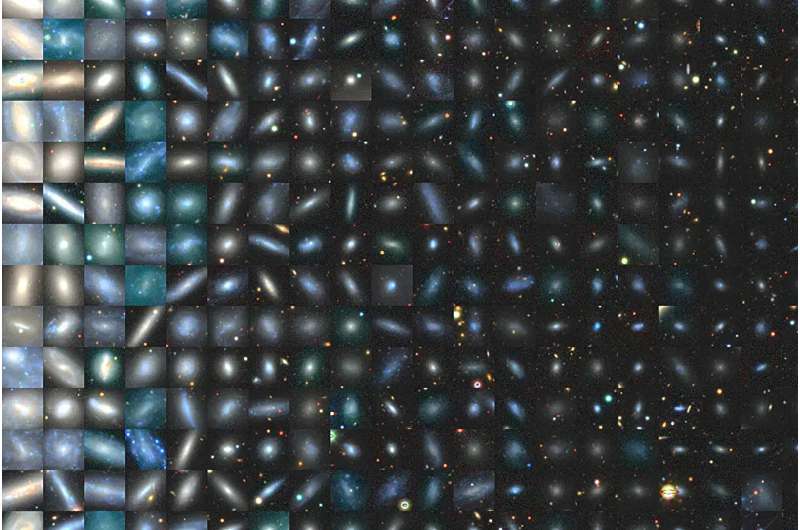
November 20, 2024 by Stanford University
Collected at: https://phys.org/news/2024-11-milky-outlier-similar-galaxies-universe.html
For decades, scientists have used the Milky Way as a model for understanding how galaxies form. But three new studies raise questions about whether the Milky Way is truly representative of other galaxies in the universe.
“The Milky Way has been an incredible physics laboratory, including for the physics of galaxy formation and the physics of dark matter,” said Risa Wechsler, the Humanities and Sciences Professor and professor of physics in the School of Humanities and Sciences. “But the Milky Way is only one system and may not be typical of how other galaxies formed. That’s why it’s critical to find similar galaxies and compare them.”
To achieve that goal, Wechsler cofounded the Satellites Around Galactic Analogs (SAGA) Survey dedicated to comparing galaxies similar in mass to the Milky Way.
After more than a decade of scanning the universe, the SAGA team identified and studied 101 Milky Way-like analogs as a first step in its ongoing research. The results, published in three studies in the Nov. 18 issue of The Astrophysical Journal, reveal that, in many ways, the evolutionary history of the Milky Way is different from other comparable-sized galaxies.
“Our results show that we cannot constrain models of galaxy formation just to the Milky Way,” said Wechsler, who is also professor of particle physics and astrophysics at the SLAC National Accelerator Laboratory. “We have to look at that full distribution of similar galaxies across the universe.”
In addition to Wechsler, the SAGA project is led by Professor Marla Geha at Yale University and Yao-Yuan Mao, Wechsler’s former doctoral student at Stanford, now an assistant professor at the University of Utah. All three co-authored the newly published studies.
Dark matter mystery
The Milky Way is made of ordinary atomic matter, like hydrogen and iron. But ordinary matter only accounts for about 15% of matter in the universe. The remaining 85% is mysterious, invisible dark matter.
“No one knows what dark matter is made of,” Wechsler said. “It doesn’t interact with ordinary matter or light. There’s probably dark matter running through you right now and you don’t even know it.”
Studies show that galaxies form inside massive regions of dark matter called halos. A dark matter halo may be invisible, but its enormous size creates a gravitational force strong enough to pull in ordinary matter from space and transform it into stars and galaxies.
A key objective of the SAGA Survey is to determine how dark matter halos impact galactic evolution. To begin, the SAGA team focused on galactic satellites—small galaxies that orbit much larger host galaxies like the Milky Way.
The researchers identified four of the Milky Way’s brightest satellite galaxies, including the two biggest, known as the Large and Small Magellanic Clouds (LMC and SMC). The scientists then conducted a painstaking search for satellites around other host galaxies similar in mass. Using telescopic imaging, they eventually identified 378 satellite galaxies surrounding 101 Milky Way-like hosts.
“There’s a reason no one ever tried this before,” Wechsler said. “It’s a really ambitious project. We had to use clever techniques to sort those 378 orbiting galaxies from thousands of objects in the background. It’s a real needle-in-the-haystack problem.”

New findings
In one of the three new SAGA studies, researchers found that the number of satellites per host galaxy ranges from 0 to 13. The Milky Way’s four observable satellites fit within that range.
The study also revealed that host galaxies with large satellites, similar in size to the Milky Way’s massive LMC and SMC galaxies, tend to have more satellites overall. But the Milky Way actually hosts fewer satellites than similar galaxies, making it an outlier among its peers.
A second study focused on star formation in satellite galaxies—an important metric for understanding how galaxies evolve. The study found that in a typical host galaxy, smaller satellites are still forming stars. But in the Milky Way, star formation only occurs in the massive LMC and SMC satellites. All the smaller satellites have stopped forming stars.
“Now we have a puzzle,” Wechsler said. “What in the Milky Way caused these small, lower-mass satellites to have their star formation quenched? Perhaps, unlike a typical host galaxy, the Milky Way has a unique combination of older satellites that have ceased star formation and newer, active ones—the LMC and SMC—that only recently fell into the Milky Way’s dark matter halo.”
The study also found that star formation typically stops in satellite galaxies located closer to the host, perhaps because of the gravitational pull of dark matter halos in and around the host galaxy.
“To me, the frontier is figuring out what dark matter is doing on scales smaller than the Milky Way, like with the smaller dark matter halos that surround these little satellites,” Wechsler said.
The third study, led by Stanford doctoral scholar Yunchong “Richie” Wang, compares the new data to computer simulations and calls for the development of a new model of galaxy formation based in part on the SAGA Survey.
“SAGA provides a benchmark to advance our understanding of the universe through the detailed study of satellite galaxies in systems beyond the Milky Way,” Wechsler said. “Although we finished our initial goal of mapping bright satellites in 101 host galaxies, there’s a lot more work to do.”
More information: Yao-Yuan Mao et al, The SAGA Survey. III. A Census of 101 Satellite Systems around Milky Way–mass Galaxies, The Astrophysical Journal (2024). DOI: 10.3847/1538-4357/ad64c4
Marla Geha et al, The SAGA Survey. IV. The Star Formation Properties of 101 Satellite Systems around Milky Way–mass Galaxies, The Astrophysical Journal (2024). DOI: 10.3847/1538-4357/ad61e7
Yunchong Wang et al, The SAGA Survey. V. Modeling Satellite Systems around Milky Way–Mass Galaxies with Updated UniverseMachine, The Astrophysical Journal (2024). DOI: 10.3847/1538-4357/ad7f4c
Journal information: Astrophysical Journal

Leave a Reply